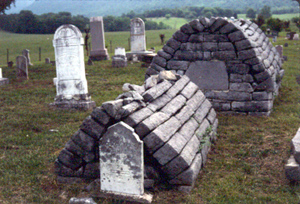
Bledsoe County
The oldest and northernmost county in the Sequatchie Valley is Bledsoe County; it became Tennessee’s thirty-third county by an act of the Tennessee legislature in November 1807. It was named for Anthony Bledsoe, a Revolutionary War patriot who migrated to Tennessee from Virginia in the late 1700s.
Nature divided Bledsoe County’s 404 square miles into three distinct regions: Sequatchie Valley, Cumberland Plateau, and Walden Ridge. In 1795 John McClellen and Charles McClung explored the area of the Sequatchie Valley that would become Bledsoe County. They praised the rich soil as equivalent to any land in the world, but settlers generally avoided the area until after the Third Tellico Treaty of 1805. Several early settlers accepted Sequatchie land as payment for service in the Revolutionary War.
In 1816, when the decision was made to move the county seat from its first location at Madison, Charles Love of Virginia sold thirty acres of land on Sequatchie Creek to the commissioners for the establishment of Pikeville; the price was $110.25. Located on the stage route from Knoxville to Huntsville, Alabama, the town developed as a trade and supply center for farmers. Pikeville has changed little since the early twentieth century, with houses surrounding the county courthouse, a neoclassical building listed in the National Register of Historic Places. The Lincoln School, an early twentieth-century African American school and community center, stands on the north end of town.
The school, which is also listed in the National Register, was constructed in 1925-26 with support from the Julius Rosenwald Fund. Just off the square is another National Register property, the Pikeville AME Zion Church, the core of which dates to circa 1870, when the building was to serve as Freedmen’s Bureau school and church. The town’s older residential district is also listed in the National Register.
The first schools in Bledsoe County were one-room log buildings which served both as schools and as churches. In 1826 the State of Tennessee authorized the establishment of Lafayette Academy in Pikeville. The school operated until after the Civil War. In 1990 Bledsoe County operated three elementary schools–on the Cumberland Plateau, on Walden Ridge, and at Pikeville–in addition to the centrally located high school at Pikeville. There have been three colleges associated with the Methodist Church in or near Pikeville: the People’s College, Bledsoe College, and Sequatchie College.
During the nineteenth century, the Methodists exerted the strongest religious influence in the county, followed closely by the Baptists. The first religious services were held in the settlers’ homes. One of the earliest church buildings was the log structure erected by Thomas Swafford sometime between 1820 and 1827 and named Swafford Chapel. First replaced by a larger frame building in 1853 and then rebuilt after the Civil War, the present church was completed in 1912. In addition to the Methodist and Baptist churches, the Cumberland Presbyterian Church and the Christian Church established congregations in Bledsoe County in the nineteenth century. The 1990 census counts more than sixty churches located in the county, almost half of which are Baptist.
Bledsoe County has provided several notable political figures. Isaac Stephens (1782-1862) served three terms in the Tennessee General Assembly, beginning in 1813. He was commissioned as a captain in the Thirty-first Militia Regiment, a large portion of which volunteered for service in the War of 1812. James Standifer (1776-1837) began his long political career as a member of the first Bledsoe County Court. He represented Bledsoe County in the state Senate, 1815-23. Elected to the U.S. House of Representatives in 1822, he served five terms, 1823-25 and 1829-37, and died in 1837 on his way to Washington. A farmer and surveyor, Standifer had business interests in Vicksburg, Mississippi, and New Orleans. James B. Frazier, an attorney with little political experience, won the gubernatorial election in 1902 as a Democrat. In 1906 he was reelected but resigned after his inauguration to fill the unexpired term of U.S. Senator William B. Bate, who had died in March 1907.
Bledsoe Countians had divided sentiments over the Civil War. The county voted against secession, but after Tennessee withdrew from the Union in 1861, several Confederate companies were organized in the county. Other Bledsoe men served in the Union army. James G. Spears, a Democrat and slave owner, joined the Union and advanced to the rank of brigadier general.
In 2000, the population of Bledsoe County stood at 12,367, of which 1,781 reside in Pikeville. The thirty-three-bed Bledsoe County Hospital, the forty-nine-bed Bledsoe County Nursing Home, the Pikeville Clinic, and the Bledsoe County Public Health Department serve county health needs. TVA supplies electric power to the Sequatchie Valley Electric Cooperative, and the Dunlap Natural Gas System supplies Pikeville with natural gas. Bledsoe Countians enjoy the benefits of modern communications systems, including a local radio station (WUAT) and a weekly newspaper, the Bledsonian-Banner. Nearby Fall Creek Falls State Park offers recreational opportunities. In 1834, while touring the area in search of coal and limestone deposits, Gerard Troost, state geologist, visited the “gulf,” a large chasm on the Cumberland Plateau that was later incorporated into the park.



